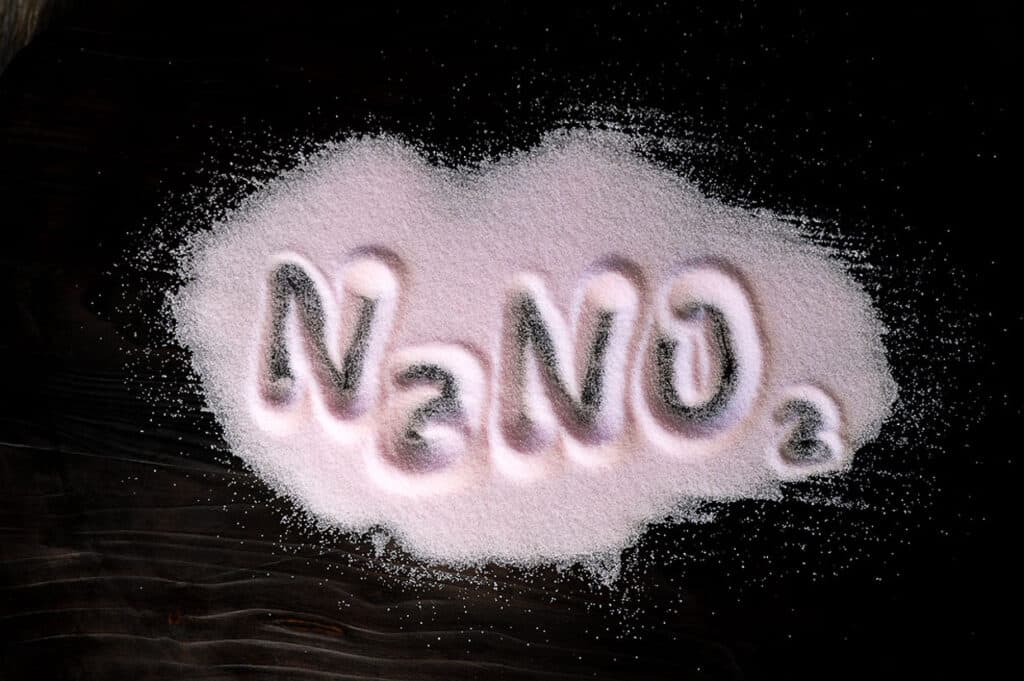Tired of feeding your sourdough starter? For your next food adventure, try making homemade bacon. The salty, smokey strips of meat are addictive and surprisingly easy to make if you understand how to use sodium nitrite.

Homemade sourdough and kombucha are made using a fermentation process. Bacon, smoked sausages, pastrami, deli meats, and salamis are made following a curing process using specific salts, like sodium nitrite.
Curing Salts
When we think of salt, most cooks are familiar with standard table salt, kosher salt, and sea salt. They’re all made up of the chemical compound sodium chloride (NaCl). They’re traditionally used to enhance the flavor of food.
Curing salts, on the other hand, are made up of sodium, nitrogen, and oxygen and are used to preserve meats.
Sodium Nitrite (NaNO2) and Sodium Nitrate (NaNO3) are the two most common curing salts. When applied to meat either through a direct application or brine, they inhibit the growth of bacteria that causes food poisoning.
The food preservative also gives cured meat products their characteristic pinkish color and unique flavor.

How To Cook With Sodium Nitrite
Today, most preserved meats in the U.S. are cured with sodium nitrite. For consumer use, the salt is sold as pink curing salt #1 or Prague powder #1. It’s colored pink so cooks don’t confuse it with regular table salt.
These products are made up of about 6 percent sodium nitrite and 94 percent table salt.
When using curing salts, it’s very important to follow reputable recipes and product packaging. Using too much curing salt can be toxic and not using enough can hinder the preservation process.
Blend
When making smoked sausages or kielbasa, pink curing salt #1 is blended in with the ground meat and spices at a ratio of one teaspoon of curing salt per every five pounds of meat.
The mixture is then cured for a couple of days in the refrigerator before it’s stuffed into casings. Then, it’s cured again after it’s cased for another one to two days before being smoked.
Rub
Curing salt can also be blended with sugar and spices and applied to the outside of meats. This method is the common way to cure pork belly to make homemade bacon.
Filled with appetizers, salads, sides, mains and desserts, Food Drink Life's cookbook will become your favorite!
- Easy and delicious recipes from a variety of top chefs and recipe developers.
- Bright, colorful pictures on every page.
- Printer-friendly recipes that you can download instantly to your device.
- Printable shopping list and a kitchen conversion sheet.
After the meat cures for a week in the refrigerator, you’ll rinse off the curing salts, so it’s okay to use two teaspoons for every five pounds of meat.
Brine
A third way to preserve meat is to mix curing salt with water and spices to create a brine. This method is common for making corned beef pastrami. For every five to seven pounds of meat, use one gallon of water mixed with two to three teaspoons of pink curing salt #1.
After the meat cures for several days in the refrigerator, rinse it, season it, and cook it.
When To Cook With Sodium Nitrate
Sodium nitrate is used to dry-cure meats like pepperoni, salami, and other dry sausages, like Spanish chorizo.
Over time, the nitrate compound in the meat converts to nitrites and then to nitric oxide. This natural conversion keeps the meat safe from bacteria, so the meat doesn’t require cooking or refrigeration.
This curing process requires precise measurements and an environment that has strict temperature and humidity controls to prevent mold.
Because it’s so complex, it’s best to leave sodium nitrates and dry curing to the pros.
What Is Tender Quick?
Another type of curing salt that can be found at your grocery store is Morton Tender Quick. The name is kind of deceiving. It’s not really a meat tenderizer. It’s a blend of salts that can reduce curing time.
While pink curing salts contain around 6 percent sodium nitrite and/or 3 percent sodium nitrate, Tender Quick contains a half percent of each.
Although it contains sodium nitrate, Tender Quick should not be used to dry-cure meats. All curing with Tender Quick should be done in the refrigerator.
Morton recommends using one tablespoon per every pound of meat for a dry brine and one cup for every four cups of water for a wet brine.
However, to all you bacon lovers out there, this is not the salt to use. The Morton website specifically states that Tender Quick is not recommended for pork belly. But you can use it to make Canadian bacon, which is prepared by curing pork loin.
Alternatives To Curing Salts
Now that you understand what it takes to make bacon, you may be asking yourself how they make nitrite-free bacon and other meat products without nitrites.
There are alternatives to man-made curing salts. Nitrate occurs naturally in some foods like celery. When celery is dehydrated and concentrated into a powder, it can be used to cure meats.
There are numerous resources out there that advise women to avoid meats prepared with curing salts during pregnancy. The nitrite-free and nitrate-free options seem like good alternatives.
However, they’re still preserved with nitrates and nitrites, just not man-made ones. The good news is that cured meats are not listed as foods to avoid on the USDA’s food guidelines for pregnant women.
What the USDA does recommend is reheating deli meats, hot dogs, and dried sausages, not because of the nitrites, but because they may contain listeria, which can cause miscarriages.
What To Do With All Your Bacon
Once you start making homemade bacon, it’s hard to stop. It’s fun to experiment and make different flavors like black pepper, Cajun, and maple.
The good news is at Food Drink Life, we’ve got you covered with 36 mouthwatering bacon recipes you need to try right now.
